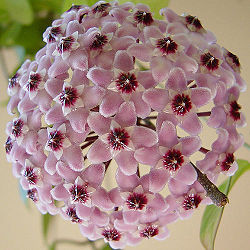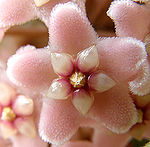Porcelainflower
| Porcelainflower |
|---|

|
| Scientific Classification |
|
| Binomial Name |
|
Hoya carnosa |
Porcelainflower is a species of flowering plants belonging to the taxonomic genus Hoya, which are sometimes called the 'Wax plants'. There are lots of species of Hoya, such as H. bella, H. multiflora, and H. australis (or H. kerrii). Hoya Carnosa is the most commonly species and the most common used of all. They are popular for cultivating because they look elegant and they are relatively easier to cultivate than other plants, especially among flowers.
| Horticultural Name | Common Name |
|---|---|
| Hoya carnosa | Wax Plant |
| Hoya carnosa `Argentea Picta' | Hindu rope (R) |
| Hoya carnosa `Compacta' | |
| Hoya carnosa `Mauna Loa' | Lura-Lei (R) |
| Hoya carnosa `Compacta Regalis' | |
| Hoya carnosa `Krinkle 8' | Krinkle 8 (R) |
| Hoya carnosa `Krinkle 8 Variegata' | Variegated Krinkle 8 |
| Hoya carnosa `Rubra' | Krimson Princess (R) |
| Hoya carnosa `Tricolor' | |
| Hoya carnosa `Variegata' | Variegated wax plant |
| Hoya purpurea-fusca `Silver Pink' | Silver pink wax plant |
Anatomy
Porcelain flower (Hoya) is a vine, which is perennial. It has over one-hundred species spreading over the tropical areas of Southeast Asia and Australia. Its stem is brown, and the aerial root protrudes to a tree or rock and attaches itself. The leaf are oval, sleek, thick, and the edges are flat. The petiole is short. It blooms in May and is shaped like a star as its stalk grows from the axil. They have a variety of colors such as white, light pink or pink, and its center is light red and glossy. They reproduce during March through May by sticking their formal year’s branches. Their representative species is Hoya carnosa, which grows up 2~3 meters, and its color is light pink. [2][3]
Reproduction
Hoya can be reproduced by people’s work as they are popular for cultivation. There is a process to reproduce Hoya appropriately. First of all, leave their leaves until they have only 2~3 leaves, and make their length about 10cm by cutting them off (when cut them, they should be cut with one cutting aslant.) Using good soil is also important; sand around river can be good one. When the roots grow enough, they are ready to move, and the appropriate temperature is around 68F. [4][5][6]
Ecology
Their habitat is in tropical and subtropical regions of Southeast Asia such as India and South of China through Australia. Even if they live in the tropical or subtropical zones, they continually require a large amount of water at least once a week, especially during the summer. Now, that they are getting popular among people to cultivate, they can be seen in neighborhoods and gardens, parks, or even inside a house; people keep and take care of them as a dilettante life. [7][8]
Tips for cultivating and usages
Hoya lives in the subtropical zones such as: China, south of Japan, or Australia; so it is bad for them to be overly moist. In the summer, because it is hotter than other seasons, people supply more water, but they should not do that because moist soil is not good for them. They should be a little dry, for a better growth condition. When you dig the soil and realize that the soil is dried up, it is the best time to water. You have to water them in a week to ten days; but if you think that they are too dry, you can water them a little early. When you water them, you should water a large amount; it helps to supply air to the root, and it helps them to grow well. During the winter, since the temperature is about 41F, you have to place them near the window, so that they can get enough sunlight. When you water them, you should balance the temperature between the room temperature and the water temperature. If the water is too cold or if you put them outside, they will most likely die due to the cold weather. The most suitable temperature for the Hoya is 59F-77F. If the temperature rises above 86F during the summer, they can not endure much and die over if people do not manage them; protect them from the sun, expose to the wind, or spray water to them. You should always care about the ventilation. If you keep them inside of your house for a long time, insect will be appeared and they will damage the plant.[9][10][11]
Video
This is a 20-hour time lapse from 2003. [12] [13]
References
- Wax Plant (Hoya) Production Guide MREC,CFREC-A Foliage Plant Research Note RH-91-35 L.S. Osborne, R.W. Henley and A.R. Chase University of Florida, IFAS Central Florida Research and Education Center - Apopka 2807 Binion Rd., Apopka, FL 32703-8504
- Wax Plant, Hoya species Molbaks, © 2002 Molbak’s Inc.
- Hoya Wikipedia, the free encyclopedia
- Hoya © 두산백과사전 EnCyber & EnCyber.com © NHN Corp.
- About Hoya Naver Knowledge, Nov. 05, 2006
- PLANTS Profile Hoya carnosa (L. f.) R. Br., porcelainflower USDA, 04/23/2009 06:13 PM
- Hoya carnosa Naver Blog Dec, 24, 2007

